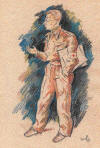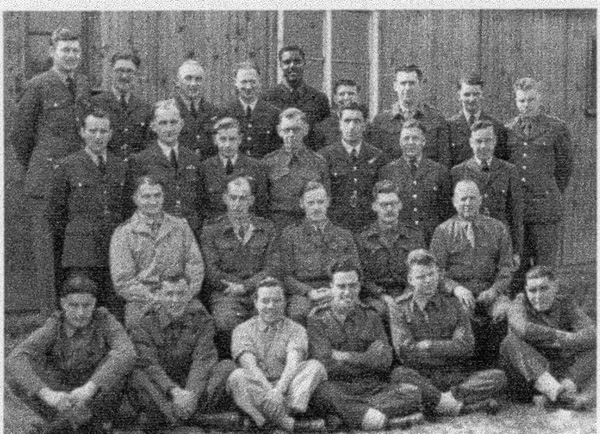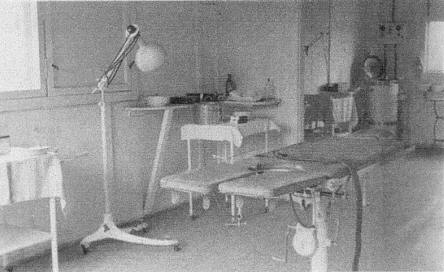|
By Judith Cameron:
My father,
Captain W. M. Nichols, landed in France on 13th May 1940. He
was part of a brand new venture, a mobile neurosurgical unit to be
deployed at the front for the first time in warfare. After a brief two
weeks in action this unit was cut off by the German advance at Krombeke,
not far from Dunkirk, while still struggling to deal with 800 wounded.
The medical officers and wounded men were sent to captured hospitals in
France and Belgium.
|

Dr. Nic |
From there Captain
Nichols and his unit were sent to a group of new prisoner hospitals in
Thuringia, and he began work there in October 1940. He was frequently in
trouble with the German authorities (he had been court-martialled for
the first time within a few days of capture, while still in Belgium) and
was moved round a number of hospitals as a result - Hildburghausen, Bad
Sulza, Molsdorf, Rotenburg and Egendorf. He made many friends at this
time and took a full part in the events of camp life. His letters
describe the amateur theatricals (his transformation into a glamorous
young woman), the sports ( cricket played with a ball of socks and a bat
of a “young tree”), efforts to learn the violin from a tutor who spoke
only Serbian, the parties, the Christmas meals, the library books (in
one place he read 50 books in a month). All this is told in a highly
entertaining style calculated to reassure his anxious family at home.
In the first week in
January 1943, after yet another falling out with the authorities, he was
sent to Stalag Luft 1, Barth, Pomerania, to be Camp Medical Officer.
What he found there was at once disappointing and a great relief. There
was no hospital and no surgical work, but the German camp staff was
helpful and reasonable, and the camp numbers were small, only about 300.
At first he was the
only medical officer there, but the camp grew very rapidly and after a
year, he begged for help and a senior officer was sent to take over.
Basically, Captain Nichols was a surgeon and though RAMC personnel had
to turn their hands to anything, a physician and a dentist were also
desirable. Col. Hankey (also captured in 1940) was both - a physician
and a dentist. The two men got on well and made a good team. By the end
of 1944, they had 5 doctors, about 6000 POWs and a hospital. A
photograph in 1945 shows about 25 medical personnel, including
orderlies. The camp numbers had risen by then to over 9000. The effort
involved in obtaining essential facilities was unremitting, and the
result of hours, days, and months of arguing, pleading, persuading and
even bargaining with the authorities.

Medical Staff and volunteers in 1945 -
Dr.
Hankey,2nd row,3rd left; - Dr.
Nichols,2nd row,4th left; -
"Bunny"
Fogell, front row, 2nd right; - Smythe,back row,5th
left |
A
medical officer had certain advantages over his comrades. Firstly, he
had a job to do; technically, he was paid; technically he was not a
prisoner of war, but was in a category described as “detained
personnel.” Of course this meant little in practise. Secondly, he was
working for his own people, infinitely preferable to forced work for the
enemy. And thirdly, he had much more freedom of movement than most other
POWs. Nichols had a pass which allowed him to visit all the compounds in
Stalag Luft 1; he accompanied wounded or sick patients to Stralsund,
Neubrandenburg, and Schwerin for hospital treatment; in Thuringia, there
were inoculation clinics to run in work camps round the country; and
there were regional meetings twice a year to present cases for
repatriation . All this brought him in contact with many German
officers, guards, and even occasionally civilians.
To begin with,
in Stalag Luft 1, Capt Nichols had to operate in the most primitive
conditions. He describes his first appendix operation, using improvised
instruments – pot handles and pokers, sterilised in pots and pans on the
barrack stove. In “POWerful Memories”, written by Augustine Fernandez,
there is a vivid and affectionate description of such an operation from
the victim’s point of view! In “Behind Barbed Wire” by Morris Roy, the
doctor is described as a “ dynamic and energetic personality”, and he
took pride in making good the shortcomings of prison life, protecting
his patients and boosting morale whenever possible. He relied on
volunteers to help with the nursing and trained many non-medical
assistants who became extremely efficient as anaesthetists and operating
theatre staff. He spoke highly of the dedication of these men, many of
whom had been patients themselves.
|


Personal Identity Card and Camp
Pass of Dr. Nichols |
Nichols had made
friends with the German doctors in the camp, and they greatly assisted
him to equip his little hospital. One of them, Dr. Gunther Obst, gave
the anaesthetic for that first operation (illegally, as permission to
assist had been denied by Obst’s superiors). The two men became firm
friends. Dr.Obst spoke good English, and they had many interests in
common. They shared their enthusiasms, talked of books and mountains,
languages and music, admired photographs of each other’s families, and
dreamed of life after the war. A favourite daydream was to own a car
with a radio, so that you could enjoy the freedom of the open road
across Europe while listening to Bach at the same time – a dream in the
realms of fantasy in 1943. Obst would unobtrusively admit Nichols to the
German Officers mess to listen to concerts on records, and on at least
one occasion took him to the Marienkirche (the church that could be seen
from the camp) in Barth to hear the beautiful
Buchholz organ which he played himself. Nichols was introduced to Obst’s
fiancée, Ruth. Invitations to concerts were also issued by Oberst
Scherer, the camp commandant, and the head of security was also a music
lover, which indicates that at that time the officers of both sides were
on good terms.
Doc Nic tells how
the German doctors conspired with him to go out with a lorry at night
and steal a whole X-ray plant from a disused hospital. “The only
drawback was that we couldn’t give away our theft by indenting for new
X-ray film and I had to screen everything, drawing what I saw on paper
in the dark”. This happy state of affairs was not to continue for long.
Perhaps an officious Nazi began to complain about the co-operation, or
perhaps the two men were not circumspect enough even for a sympathetic
commander like Scherer. Dr. Obst found himself in serious trouble and he
was dismissed from his post and transferred to Stettin as a disciplinary
penalty. Dr. Thomas Obst, Gunther’s son, thinks this took place at the
end of 1943 as a direct result of assisting at the appendix operation
against orders. This date is well before the major purge of German
officers, including Scherer himself, which took place at the end of
1944. Obst’s name does not appear on the list of officers who were
dismissed with Scherer. Nichols writes in home letters of German
officers assisting in operations in May ’43 and again in September’43,
but he does not name them.
Even before his
arrest, Dr. Obst had become unwell. Perhaps because of this, he was
never brought to trial, and was transferred to hospitals as a patient,
and then back to his home in Halle as his health deteriorated.
Nichols’ work grew
with the camp. At first he had been active with the orchestra, the
plays, much reading and giving lectures, but as more and more American
flyers arrived in the camp he had no time for all of these recreations.
He took up swimming and fencing in an attempt to keep fit, fighting up
and down the wards and over the beds with one of his orderlies, a man
called “Bunny” Fogell – loud cheers from the poor patients as they
hacked and lunged at each other Musketeer style!
The workload now
might include 100 patients a day on sick parade, and there was an urgent
need for a new, or extended, hospital. After months of designing and
planning, this was completed in November 1944, and there are photographs
of a visit by a German General, who was delighted to see such a
civilised enterprise in this remote camp. An absolutely essential
refinement to the new surgical theatre was the acquisition of linoleum
for the floor. The floorboards of the hut were so ill-fitting “ that the
Baltic sand simply spouted up when the wind blew, and covered equipment
and patient in a gritty layer.” Before linoleum, “one did not operate
when the wind was in the East.” By constant badgering and cajoling, a
proper operating table, steam steriliser, and lamps were requisitioned
to complete the workplace. In spite of this improvement, however, there
were never enough medical supplies in the way of drugs, instruments and
dressings. Nichols had to fight for every bit, and 80% was provided by
the Red Cross, along with vital invalid food. The linoleum came from the
Swedish YMCA, whose representative was part if the IRC Association’s
inspection team.
|

Operating Room at Stalag Luft I |
Descriptions of surgical
procedures include hernia, appendix, many American football accidents,
and wound surgery. Of the two prisoners shot by the camp guards, Lt
Wyman was moribund before he reached the hospital, but Nichols kept in
touch after the war with George Whitehouse, the South African officer
who survived. He sent me a copy of a children’s classic, “Jock of the
Bushveldt”, which I still have.
The last few weeks
of the war and the two weeks which followed, were hectic. The medical
officers were fully stretched dealing with the poor creatures found at
the local concentration camp, as well as preparing the hospital for
evacuation and also some work with the civilian population in Barth
(including a maternity case). At home, Martin Nichols never spoke of the
concentration camp and his work there, preferring to retell the many
stories of amusing or unusual events that took place during his 27
months at Stalag Luft 1. The Senior Allied Commanding officer, Colonel
Zemke, tells the story of honouring an obligation to three German
civilians by smuggling them out with the wounded. These girls were on
the camp staff as secretaries and translators, had been helpful to the
prisoners and quite probably faced ‘a fate worse than death’ if left
behind at the mercy of the Russian army. The Russians absolutely forbade
the removal of any German citizen, but Nichols and Hankey disguised them
in nurses’ uniforms, and they flew to Britain with Nichols on 13th
May 1945, exactly five years to the day since he had set foot in France.
On
arrival, Doc Nic had to endure a good deal of teasing about bringing
home not one, but three German women! The girls were eventually
returned home to Germany, not knowing what they might find.
Miraculously, their homes and their families were still there to welcome
them. Ursula and Irma were to remain friendly with Martin all his life.
When, in 1958, the family visited them in Germany, it was obvious that
they regarded Doc Nic as somehow personally responsible for their safe
return. We were made wonderfully welcome.
Martin
brought home with him a mass of drawings, photographs, and other
memorabilia, which became part of our childhood, as well as the many
stories of his adventures. When I went with my brother and sister to
visit Barth in 2005 to meet up with POW survivors and their families, it
was the first time in our lives that we had met other people who shared
these same stories and pictures – a most moving experience.
|

Dr. Gunther Obst |
Perhaps the most precious thing he brought back was his continuing
friendship with Gunther Obst. After the war, Gunther was able to get in
touch with Martin, and the letters from Germany make for very difficult
reading. Conditions there were quite terrible, and jobs almost
impossible to find. That a highly trained ophthalmologist like Obst was
driven to plead in his letters for darning wool and tobacco gives only
the smallest indication of the situation then prevailing. The Obst
family escaped with many starts and alarms from the Russian zone, but
his circumstances were not much improved. In poor health, and without
political influence, he had little chance of a permanent job. Desperate
for work and security, people would do almost anything and trample on
anyone to achieve these things. Martin looked for a post for Gunther in
Britain through the British Council. He was told that hundreds of people
were trying to do the same thing for their German friends. Eventually an
opening was found, but it was too late; Gunther was too ill to take it
up. He died in 1952, aged 40. By that time, Martin did have a car,
though not the sort that sported the luxury of a radio, and he visited
Gunther in a hospital just a few days before he died.
Dr
Obst’s son Thomas, has been in touch with the Nichols family most of his
life, and he came with us on our historic trip to Barth in 2005. We feel
that we share with him a significant small part of our fathers’ lives,
and through both these courageous men, we lay claim to the defining
events of Europe’s recent history.
After
the war, Martin Nichols returned to neurosurgery and in 1948 was
appointed to the hospital service in Aberdeen, Scotland. There he set up
a new neurosurgical unit, which served the whole of the North-East of
Scotland, with satellite clinics in Inverness and Dundee. He was popular
as a lecturer on many subjects, and his encyclopaedic knowledge can be
ascribed in some degree to five years’ eccentric study in POW camps in
Germany. He died in 1979.
|
